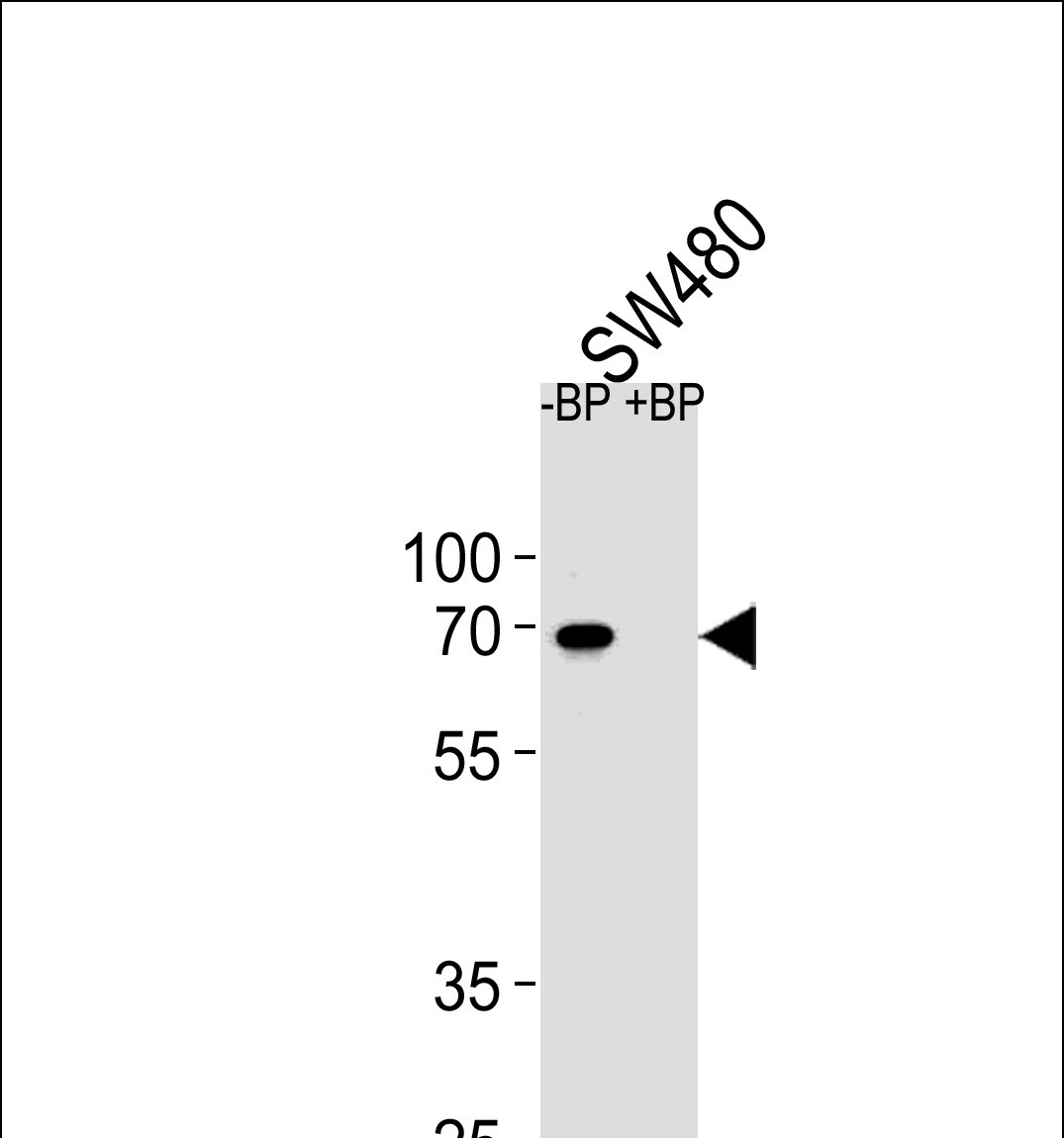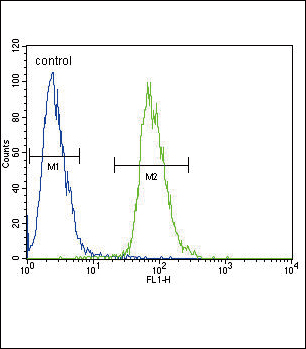ETV5 Antibody (N-term)
Affinity Purified Rabbit Polyclonal Antibody (Pab)
- 产品详情
- 实验流程
- 背景知识
Application
| FC, WB, E |
|---|---|
| Primary Accession | P41161 |
| Other Accession | NP_004445.1 |
| Reactivity | Human, Mouse |
| Host | Rabbit |
| Clonality | Polyclonal |
| Isotype | Rabbit IgG |
| Calculated MW | 57838 Da |
| Antigen Region | 8-36 aa |
| Gene ID | 2119 |
|---|---|
| Other Names | ETS translocation variant 5, Ets-related protein ERM, ETV5, ERM |
| Target/Specificity | This ETV5 antibody is generated from rabbits immunized with a KLH conjugated synthetic peptide between 8-36 amino acids from the N-terminal region of human ETV5. |
| Dilution | FC~~1:10~50 WB~~1:1000 E~~Use at an assay dependent concentration. |
| Format | Purified polyclonal antibody supplied in PBS with 0.09% (W/V) sodium azide. This antibody is purified through a protein A column, followed by peptide affinity purification. |
| Storage | Maintain refrigerated at 2-8°C for up to 2 weeks. For long term storage store at -20°C in small aliquots to prevent freeze-thaw cycles. |
| Precautions | ETV5 Antibody (N-term) is for research use only and not for use in diagnostic or therapeutic procedures. |
| Name | ETV5 |
|---|---|
| Synonyms | ERM |
| Function | Binds to DNA sequences containing the consensus nucleotide core sequence 5'-GGAA.-3'. |
| Cellular Location | Nucleus. |
| Tissue Location | Ubiquitous. |
For Research Use Only. Not For Use In Diagnostic Procedures.
Provided below are standard protocols that you may find useful for product applications.
BACKGROUND
The ETS family of transcription factors, characterized by an evolutionarily conserved DNA-binding domain, regulates expression of more than 300 target genes by binding to a purine-rich GGAA/T core sequence. Depending on the cellular context, they can function as transactivators or transrepressors. Ets proteins have been implicated in regulation of gene expression during a variety of biological processes, including growth control, transformation, T-cell activation, and developmental programs in many organisms. Signals regulating cell growth are transmitted from outside the cell to the nucleus by growth factors and their receptors, G-proteins, kinases and transcription factors. It was shown that ETS signal transduction is implicated in hematopoiesis and angiogenesis at the earliest stages of embryogenesis, and is later involved in tissue development. Deregulated expression and/or formation of chimeric fusion proteins of the ETS family due to proviral insertion or chromosome translocation is associated with leukemias and with specific types of solid tumors.1 Among the multiple Ets proteins, the PEA3 group consists of ETV1 (Ets variant gene 1; also called ER81), ETV4 (also called PEA3) and ETV5 (also called ERM). All three members are 95% identical in the ETS domain and more than 85% in the acidic transactivation domain. Several studies suggest that the PEA3 group proteins are involved in intestinal tumors, gastric cancer, and breast cancer metastasis. In nearly all Ewing?s sarcoma tumors, EWS, which encodes a RNA-binding protein, is fused by chromosomal translocation to an Ets gene, including FLI, ERG, ETV4, and ETV1. This results in the expression of chimeric proteins that may be important in tumor cell transformation.2 Recently, it was reported that TMPRSS2, an AR-regulated gene, is fused by translocation to the ETV1, ERG, or ETV4 gene in a subset of prostate cancers. These findings suggest an important role for PEA3 proteins in prostate cancer.3 In addition Ets family members have been correlated to tumor progression by upregulating the expression of matrix-degrading proteases. The acquisition of a migratory phenotype by the epithelial tumor cells together with the remodeling of the extracellular matrix must accompany the process of cancer cell invasion. Indeed, ETV5 has been shown to act through matrix metalloproteinase-2 gelatinolytic activity to confer invasive capabilities, associated with an initial switch to myometrial infiltration.4
REFERENCES
Fontaine-Bisson, B., et al. Diabetologia 53(10):2155-2162(2010)
Lens, Z., et al. Biochem. Biophys. Res. Commun. 399(1):104-110(2010)
Ng, M.C., et al. J. Clin. Endocrinol. Metab. 95(5):2418-2425(2010)
Jugessur, A., et al. PLoS ONE 5 (7), E11493 (2010) :
Elks, C.E., et al. PLoS Med. 7 (5), E1000284 (2010) :
终于等到您。ABCEPTA(百远生物)抗体产品。
点击下方“我要评价 ”按钮提交您的反馈信息,您的反馈和评价是我们最宝贵的财富之一,
我们将在1-3个工作日内处理您的反馈信息。
如有疑问,联系:0512-88856768 tech-china@abcepta.com.























 癌症的基本特征包括细胞增殖、血管生成、迁移、凋亡逃避机制和细胞永生等。找到癌症发生过程中这些通路的关键标记物和对应的抗体用于检测至关重要。
癌症的基本特征包括细胞增殖、血管生成、迁移、凋亡逃避机制和细胞永生等。找到癌症发生过程中这些通路的关键标记物和对应的抗体用于检测至关重要。 为您推荐一个泛素化位点预测神器——泛素化分析工具,可以为您的蛋白的泛素化位点作出预测和评分。
为您推荐一个泛素化位点预测神器——泛素化分析工具,可以为您的蛋白的泛素化位点作出预测和评分。 细胞自噬受体图形绘图工具为你的蛋白的细胞受体结合位点作出预测和评分,识别结合到自噬通路中的蛋白是非常重要的,便于让我们理解自噬在正常生理、病理过程中的作用,如发育、细胞分化、神经退化性疾病、压力条件下、感染和癌症。
细胞自噬受体图形绘图工具为你的蛋白的细胞受体结合位点作出预测和评分,识别结合到自噬通路中的蛋白是非常重要的,便于让我们理解自噬在正常生理、病理过程中的作用,如发育、细胞分化、神经退化性疾病、压力条件下、感染和癌症。







